ISSN ONLINE(2319-8753)PRINT(2347-6710)
ISSN ONLINE(2319-8753)PRINT(2347-6710)
| I. Nawaz Assistant Professor, Department of Mechanical Engineering, Faculty of Engineering & Technology, Jamia Millia Islamia, Jamianagar, New Delhi-110025, India |
| Related article at Pubmed, Scholar Google |
Visit for more related articles at International Journal of Innovative Research in Science, Engineering and Technology
In today’s Era energy planners are aiming to increase the use of Oil, Gas, Nuclear and also Renewable Energy sources to meet the electricity demand in India. But till now coal-based thermal power plants are the major source of electricity generation and they will continue to dominate in the next few decades too. One of the major disadvantages of coal-based thermal power plants is the disposal problem of Fly Ash. It was earlier considered as a total waste and an environmental hazard, thus its use was limited, without much understanding. Fortunately, its useful properties have now begun to be known as raw material for various applications. Now-a-days NTPC, DST, CPRI, CSMRS, BARC, CBRI, etc. are working with Ministry of Environment & Forests and Ministry of Power, Government of India to formulate a strategy to find out the proper use of this waste material. As an outcome of their efforts, Fly Ash is being very effectively and economically used in building components such as bricks, doors, door-frames, etc. Fly Ash is also being used in construction of roads and embankments with some design changes. It is also used as raw material in agricultural and wasteland development programmes. The trend is clear, Fly Ash will soon be considered as a resource material and its potential will be fully exploited. Through development & application of technologies, Fly Ash has shifted from “Waste Material” category to “Resource Material” category. The purpose of this paper is to provide an overview of disposal and utilization of Fly Ash and its beneficial potential in application of civil engineering construction as well as others.
Keywords |
| Fly Ash, coal-based thermal power plants, disposal of Fly Ash, utilization of Fly Ash, waste material, resource material, environment |
INTRODUCTION |
| Coal-based thermal power plants have been a major source of power generation in India where about 57% of the total power obtained is from coal-based thermal power plants [1]. Fly Ash is a by-product material being generated by thermal power plants from combustion of Pulverised coal. High ash content is found to be in range of 30% to 50% in Indian coal [2]. The quantum of Fly Ash produced depends on the quality of coal used and the operating conditions of thermal power plants. Presently the annual production of Fly Ash in India is about 112 million tonnes with 65000 acre of land being occupied by ash ponds and is expected to cross 225 million tonnes by the year 2017 [3]. Such a huge quantity does pose challenging problems, in the form of land usage, health hazards and environmental dangers. Both in disposal as well as in utilization, utmost care has to be taken to safeguard the interest of human life, wild life and environment. When pulverised coal is burnt to generate heat, the residue contains 80% Fly Ash and 20% bottom ash [4]. A huge volume of Fly Ash produced from coal-based thermal power plants may bring several problems from environmental point of view. Fly Ash particles ranging in size from 0.5 to 300 micron in equivalent diameter, being light weight, have potential to get airborne easily and pollute the environment [5]. If not managed properly Fly Ash disposal in sea/rivers/ponds can cause damage to aquatic life also. Slurry disposal lagoons/ settling tanks can become breeding grounds for mosquitoes and bacteria. It can also contaminate the under-ground water resources with traces of toxic metals present in Fly Ash. Huge investments/ expenditures are made just to get Fly Ash out from the thermal power plants and dump it in the ponds. If understood and managed properly, it can prove to be a valuable resource material. |
CHEMICAL COMPOSITION & PHYSICAL PROPERTIES OF FLY ASH |
| Chemically, Fly Ash is considered as amorphous and mixture of Ferro-alluminosilicate minerals. However, composition of Fly Ash depends mainly upon the geographical factors related to coal deposit, combustion conditions and the type of ash collection devices. The major constituents of Fly Ash are primarily oxides of Si, Al, Fe, Ca, and Mg which constitute about 95-99% of total constituent. Minor constituents of Flay Ash are Ti, Na, K, and S comprises 0.5- 3.5%. A typical chemical composition & physical properties are given in Tables 1&2 [6, 7]. |
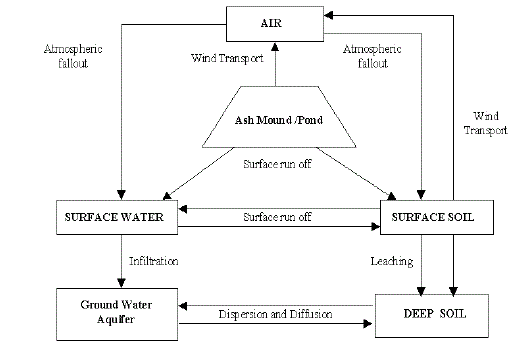 |
OPTIONS FOR FLY ASH HANDLING |
| The amount of Fly Ash produced today cannot be ignored. Options available for Fly Ash handling are disposal and utilization. These two options are reviewed and the respective environmental concerns are addressed here. |
DISPOSAL OF FLY ASH |
| In the past, Fly Ash produced from coal combustion in thermal power plants was simply dispersed into the atmosphere. At thermal power plants, Fly Ash is presently collected or disposed by using either dry or wet systems. Worldwide, more than 65% of Fly Ash is disposed in landfills and ash ponds [8]. The Fly Ash is a resource material, if not managed well, this may pose environmental and health problems. |
| A. Dry Fly Ash Disposal system |
| In dry disposal system, electrostatic precipitation (ESP) is the most popular and widely used method of emission control today which enables collection of dry Fly Ash. After collecting the Fly Ash in ESP, it is then transported by trucks or conveyors at the sight and disposed of by constructing a dry embankment. |
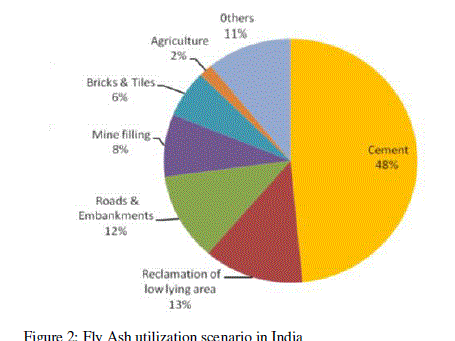 |
| B. Wet Fly Ash Disposal System |
| In wet disposal system, the Fly Ash is mixed with water and transported as slurry through pipe and disposed of in ash ponds or dumping areas near the plants. Being cheaper than any other manner of Fly Ash removal, it is widely used method at present in India. |
| C. Environmental Considerations |
| The environmental aspect of Fly Ash disposal aims at minimizing air and water pollution. Directly related to these concerns is the additional environmental goal of aesthetically enhancing ash disposal facilities. The Fly Ash produced by thermal power plants can cause all three environmental risks-air, surface water and ground water pollution. The pathways of pollutant movement through all these modes are schematically represented in Figure 1. |
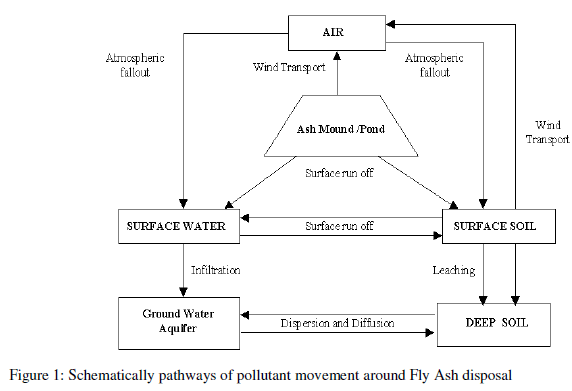 |
UTILIZATION OF FLY ASH |
| Sustainable utilization of Fly Ash is one of the key concerns of NTPC. Utilization of Fly Ash is not only possible, it is essential. Today’s quantum of production and the method of disposal do not lead to sustainability, but may instead lead to a series of catastrophes. As the demand for energy grows further, production of Fly Ash is inevitable, since India has no alternative but to use its relatively vast resource of poor grade coal- washed or otherwise. Fly Ash with its entire problem is here to stay; at least in the foreseeable future, though its negative impact can be minimized. In developed countries more than 80% Fly Ash is used for the manufacture of bricks, cellular concrete blocks, road construction, landfill application, ceramics, agriculture, insulating bricks, recovery of metals, and dam constructions [8]. While in India about 10% ash is utilised currently in various segments include cement, asbestos-cement products & concrete manufacturing industries, land development, road embankment, building products such as bricks/tiles/blocks, reclamation of coal mine, ash dyke construction and as a soil amender and source of micro and macro nutrients in agriculture and only about 3% ash is utilised in other construction industry. In India “Fly Ash Mission of Government of India” is the nodal agency which undertook the responsibility for safe disposal and gainful utilization of Fly Ash on sustainable basis. Due to concerned efforts of the Fly Ash Mission, it has slowly become an acceptable material now and its intrinsic worth has been revealed to people. |
UTILIZATION OF FLY ASH IN AGRICULTURE |
| Fly Ash has a potential in agriculture and related applications. The Indian Fly Ash is alkaline and as such improves soil quality. In fact, Fly Ash consists of all elements present in soil except organic carbon and nitrogen. In a research conducted by Maharashtra State Electricity Board considering all factors like soil quality, doses of chemical fertilizers, cyclic sowing of different food grains etc., it is found that with dose of 10 MT Fly Ash per hectare and just 50% dose of chemical fertilizers (as annually required) there is increase of 20% yield in terms of grain and fodder [9]. Fly Ash also maintains porous structure of soil and provides micronutrients. Presence of micro and macro constituents like Potassium, Boron, Calcium, Zinc etc. improves the fertility of soil. CPRI Bangaluru has developed porous and hollow globules from Fly Ash. These globules if buried around crop, absorbs the water and retain it for longer period by resisting evaporation. This application helps to widen the gap between two watering cycles. Fly Ash improves the pH value of soil when used in low pH acidic soil. It can also be used as insecticide and if used along with bio-waste, it significantly supplements the utility of chemical fertilizers. Various crops have been grown and harvested in varying agro-climatic conditions and different soil-crop combinations and increase in crops yield is mentioned in Table 3 [10]. |
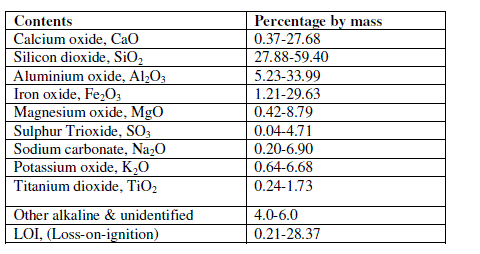 |
UTILIZATION OF FLY ASH IN BUILDING MATERIALS |
| Fly Ash could be used as prime component for a variety of construction materials. Since Fly Ash is a Pozzolanic material containing silica in good proportion. It has tremendous potential to be used as an alternative material for building construction. Some potential areas of building construction where Fly Ash can be used effectively and economically are described below: |
| A. Ready-Mixed Fly Ash Concrete |
| The process of producing ready-mixed Fly Ash concrete consists of two operations i.e. proportioning of Fly Ash concrete mix and batching & mixing of different ingredients. The ready-mixed concrete has the advantage of better quality control, reduction in wastage, labour and supervision, which are normally associated with concrete prepared at site. |
| B. Precast Fly Ash Concrete Units |
| Fly Ash can be used in production of various types of precast building units such as solid and hollow core slabs, doors and window frames etc. It can also be used in preparing of flooring and roofing units, such as cored units, channel units and cellular units by partial replacement of cement. |
| C. Clay Fly Ash Bricks |
| Fly Ash can be used for production of bricks. This is due to the fact that both clay and Fly Ash are not much different in respect of their chemical composition. Further, the residual carbon content in Fly Ash brings about an economy in fuel consumption during firing of bricks. When Fly Ash is used for construction of bricks, about 0.25 to 0.80 times of clay can be replaced by Fly Ash [11]. The clay and Fly Ash are mixed in the normal way. The bricks produced using Fly Ash has the advantage of being lighter in weight as the density of Fly Ash is about one half of the clay. |
| D. Lime Fly Ash Bricks |
| Bricks of high strength possessing good quality can be produced from Fly Ash using Lime as a binder. The Fly Ash Lime building bricks can be used in all types of brick masonry. Fly Ash Lime Bricks are obtained from materials consisting of Fly Ash in major quantity, Lime and an accelerator e.g., gypsum as a catalyst. They are generally manufactured by inter-grinding or blending the various raw materials which are subsequently moulded into brick and subjected to auto-claving under saturated steam at a pressure of about 14 kg/cm2 [12]. |
| E. Lime Fly Ash Cellular Concrete |
| Light weight aerated concrete or cellular concrete can be manufactured by a process involving mixing of Fly Ash, quick lime and gypsum in a high speed mixer to form a thin slurry. A small amount of foaming agents such as aluminium provider is added and mixed into slurry liberating hydrogen gas. The aerated slurry is poured into steel moulds and allowed to set. The blocks are then removed after initial set and autoclaved at steam pressure. After autoclaving the blocks are allowed to cool and stocked for use. These are considered excellent products for walling blocks and fabricated floor slabs. The bulk density of the product ranges from 500 kg/cm3 to 1300 kg/cm3- such blocks are suitable for load bearing walls upto three storeyed and partition walls in multi-storeyed buildings [12]. |
| F. Sintered Fly Ash Light Weight Aggregate |
| For conversion of Fly Ash into light aggregate there is one of the potential ways of bulk disposal of Fly Ash in an economic way. The bulk density of sintered Fly Ash light weight aggregate varies from 640 kg/m3 to 750 kg/m3 [13]. The production of sintered Fly Ash aggregate is suitable for use in the production of structural light weight concrete and free cost light weight concrete building units for use as load bearing and non-load bearing elements. It has good potential in places where Fly Ash is locally available and stone aggregates are costly. |
| G. Fly Ash Sand Lime Bricks |
| The Fly Ash can be used for the production of Fly Ash Sand Lime Bricks usually known as calcium silicate bricks. Production of such bricks has technically sound proposition and is of particular advantage in areas where good quality of clay is not available. |
| H. Cement |
| Fly Ash being an artificial pozzolanic material can be used for manufacturing of Portland Pozzalona Cements (PPC), as partly replacement of cement in mortar and concrete. The cement, mortar & concrete prepared by Fly Ash gives high long term strength, low heat of hydration, low permeability and hence more durability. |
MINE FILLS |
| Utilization of Fly Ash in Mine fills has potential to consume large quantity of Fly Ash. This single application of Fly Ash can utilise about 1/4th of total Fly Ash generation [14]. It will not only save scarce river sand but also enable us to enhance coal recovery from the mines. |
ROAD CONSTRUCTION MATERIALS |
| Utilization of Fly Ash in bulk quantities for road works depending on the intersection between Coal ash and sub-grade soil. Fly Ash may be used for constructing different layers of the road pavement. Brief details are given below: |
| A. Utilization for stabilisation and sub-base/base construction |
| Sub-Base and Base layers can be constructed using coarser variety of compacted pond ash or bottom ash. Studies conducted at Central Road Research Institute (CRRI) on the effect of Lime Fly Ash stabilization on strength and other engineering properties of different types of soils have indicated as follows: |
| i. Addition of Fly Ash or Lime Fly Ash to soil decreases the maximum dry density and increases its optimum moisture content. |
| ii. The strength of soil stabilized with Fly Ash alone or Lime Fly Ash shows significant improvement in terms of ‘California Bearing Ratio’ (CBR) values. The improvement in the strength characteristic depends on the proportion of the mix and the density to which mix could be compacted. |
| iii. Results of durability tests under the alternate wetting and drying cycles indicated better performance of Lime Fly Ash alluvial sill. |
| B. Utilization of constructing semi-rigid/rigid pavements |
| Fly Ash can be used for constructing semi-rigid or rigid pavements using Lime Fly Ash concrete, Lime Fly Ash bound macadam cement Fly Ash concrete, roller compacted concrete etc. This material possesses higher flexural strength than flexible pavements. These specifications can be adopted for base courses of higher traffic density corridors and also sometimes used as wearing courses for low volume roads. |
METALLURGY |
| The Fly Ash contains about 20%-25% alumina. CPRI Bangaluru has developed a process to extract alumina from Fly Ash. About 1 tonne of Fly Ash with 400 kg of other additives like lime and gypsum can produce 150 kg of alumina and 1250 kg of Pozzolanic cement, which is a good raw material for quality bricks [15]. In some cases other metals like Zinc, Selenium etc. can also be extracted in substantial amount. |
USE OF NEW MATERIALS |
| Depletion of natural resources is a particular environmental concern to a highly technological society which depends on resources for energy, building materials and recreation. Exhaustion of natural resources viz., oil, mineral and timber will lead to deterioration in the quality of life. In order to maintain the present rate of technological development some alternative materials viz., fibre glass, reinforced plastics and glass, reinforced gypsum have a great potential of use as building materials in place of present conventional materials like timber, steal etc. Fly Ash utilization scenario in India is shown in Figure 2 [16]. |
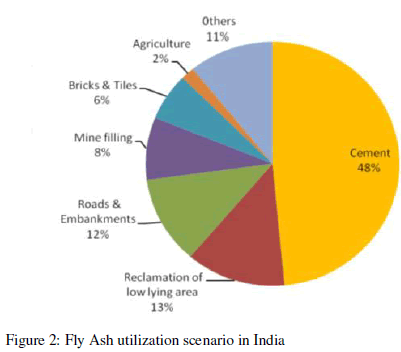 |
ENVIRONMENTAL CONTROL |
| A. Absorbent |
| The absorbents are prepared by hydrothermal conversion of glass residue of Fly Ash with aqueous alkaline earth matter. These absorbents are suitable for purification of waste gases, drinking water purification, waste water treatment and even include NH3 removal from waste water. In addition Fly Ash based absorbents can be directly used to purify the waste water and a material for absorption for gases like ammonia from waste water. |
| B. Silage |
| Organic silicon synthesised from Fly Ash had been tried to clean the sea water from oil pollution in UK. The products were prepared by treating Fly Ash with upstream of air flow cottoning silanes or organic silicon. This technique is very cheap. Organic silicon was also prepared by another method in France. The silicon Fly Ash was scattered on the sea surface, to absorb the oil agglomerates and precipitate would finally settle at sea bottom together with the pollutants. |
| C. Alkaline resistant fibres |
| Fly Ash was utilized as a raw material for making various structural materials and alkaline resistant fibres useful infiltration of aggressive chemicals. |
ENERGY SAVING AND ENVIRONMENTAL BENIFITS |
| Most of developing countries face energy scarcity and huge housing and other infrastructure shortage. Ideally in these countries, materials for habitat and other construction activities should be energy efficient (having low energy demand). Major pathway and opportunity for resource efficient, low carbon inclusive growth is shown in Table 4 [16]. |
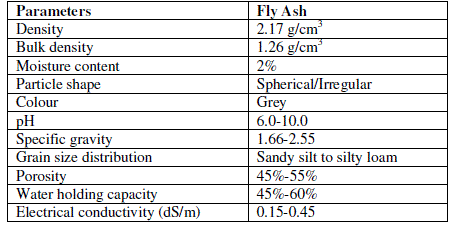 |
ADVANTAGES OF FLY ASH UTILIZATION |
| There are numerous advantages of Fly Ash utilization some of them are follows: |
| Saving of space for disposal |
| Saving of scare of natural resources |
| Energy saving, firstly because the material is automatically produced as a by-product and no energy is consumed for its generation and secondly because it can replace material which otherwise would need to be produced by consuming energy |
| Protection of environment, as in construction it can partly replace cement, production of which entails energy consumption and CO2 emissions. |
SUGGESTIONS |
| In a free economy the objective of Power Plants organisations in terms of business administration should be the cost effective disposal of Fly Ash and its utilization from the point of view of a nation’s economy the utilization of Fly Ash by-products involves various advantages which justify proceeding with the utilization despite higher costs. This additional expenditure however should be initiated following policy interventions: |
| State governments should provide land in the vicinity of thermal power plants on lease basis to the entrepreneurs for setting up of Fly Ash based building material plant. |
| Capital required for conversion coal ash into eco-friendly products intermediates should be included in the capital cost of thermal power plants. |
| Fly Ash should be incorporated in all relevant documents as a material fit for use in landfills and other construction uses. |
| The Fly Ash utilization industries should be given fiscal concessions being eco-friendly. |
| Regular supply of adequate quantity of proper quality Fly Ash. |
| Specifications for Fly Ash based building materials should be standardized and their use must be promoted. |
| Fly Ash based industries must be exempted from import and custom duties on all imported equipment and spare parts. |
| Price difference between ordinary and Portland cement (OPC) and Pozzolana Portland cement (PPC) should be brought back and all Government agencies should promote use of PPC. |
| All new power plants should have facility for dry collection of Fly Ash and its disposal to consuming industry and old must build these. |
| All roads constructed in the vicinity of the thermal power plants should use Fly Ash. |
| Use in landfill with top soil in the cities around power plants must be encouraged. |
CONCLUSION |
| A number of environmental problems have been brought to light. Ways to control these problems have been critically analysed and it was deduced that huge amount of Fly Ash is available as a by-product of coal-based thermal power plants. Its safe disposal is a great problem. At present Fly Ash is dumped in ponds. Use of Fly Ash in civil engineering construction and others have been taken up. Some new materials viz., fibre glass reinforced plastics and glass reinforced gypsum have also been discussed. |
| Fly Ash has become an important material for various industrial and construction applications. It is widely used in manufacturing of bricks, cement, asbestos-cement products and road/embankments. The studies are carried out for improvement in yield of agricultural crops, wastelands, etc. It can also be used in reinforced concrete construction since the alkaline nature will not corrode steel. This not only solves its disposal problems, but also helps in conserving the precious top soil required for growing food crops. On the basis of the studies carried out on Fly Ash utilization, it is sighted that use of Fly Ash in building construction poses great gains. If we make proper arrangement of safe disposal and optimum use in civil engineering construction, agriculture, etc. Utilization of Fly Ash also creates significant benefits in terms of energy saving as well as environment. |
References |
|